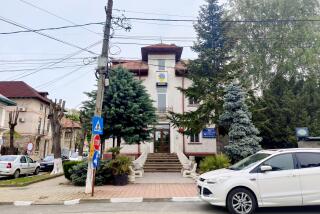Government Needs Hard Foreign Currency : Communist Romania Rolling Out Red Carpet for Students From West
BUCHAREST, Romania — Dozens of people seeking dental care waited quietly in an untidy, poorly lighted hallway in the school of dentistry here. Beyond a wooden partition, students hovered over patients in 30 operating chairs crammed into a single open space.
The Spartan facilities and overcrowding were familiar to Romanians enduring the fifth year of siege-style economic austerity.
But the majority of the white-coated students working that shift were foreigners, and they came from places as diverse as Israel, Greece, West Germany and Chile.
Romania, an isolated Balkan country ruled by one of the most repressive of Communist governments, may seem an odd place for Westerners to study dentistry. Americans are also represented here--16 are enrolled in Bucharest’s dental school, and more study at the facility in the Transylvanian town of Cluj.
‘Lot of Experience’
“People from all countries can find good training in our university,” Dr. Corneliu Burlibasa, head of the department of dental surgery, said. “We have a lot of experience in working with foreigners, and they know our tradition.”
Indeed, Romania has become the site of one of the most unusual educational enterprises in modern-day Europe. Anxious to build ties with non-Communist nations and desperate for ways to earn foreign currency, the maverick Soviet Bloc government of Nicolae Ceaucescu has converted a major part of its higher education system into a training service for foreigners.
The result has been an apparent windfall of fees from about 20,000 foreign students, a pool of graduates in key Third World nations and a sometimes-volatile flavoring of social life in Bucharest, Cluj and the two other university towns, Iasi and Timisoara.
“It’s hard to say who absorbs the bigger shock, the students who come here and discover life in Romania or the Romanians who run into operators in the black market (a sideline for many students) who are from Sudan and Iraq,” a Western diplomat said. “It’s one of the things that makes this place different.”
In a nation that tightly restricts movement across its borders and requires citizens to report all contacts with foreigners to the police, all would-be students appear welcome--provided that they bring hard cash.
Government officials say that students have come from more than 100 countries and make up a substantial majority of the enrollment in the country’s medical and dental schools. At the Bucharest dental school, 885 of 1,200 students--73%--are foreigners.
Sixty percent of the students come from developing countries, according to officials, who point out that their presence is an important element of Ceaucescu’s relatively independent foreign policy within the Warsaw Pact alliance.
The Middle East, an occasional focus of Romanian diplomacy, is strongly and diversely represented. Although more than 1,500 students come from Syria and 500 from Libya, Israel has 1,000 citizens here.
Officials say that no Romanian student has been allowed to study in the West since 1981, when troubles in paying the country’s hard-currency debts inspired Ceaucescu to impose a drastic regimen of austerity. But there are more than 3,000 Greeks and 400 West Germans here. Almost all are enrolled in the schools of medicine and dentistry.
For Westerners, the appeal of Romania is simple--almost anyone willing to pay, and spend an extra year learning Romanian, can get a medical degree here. Most of the Americans, officials say, also come from resettled Romanian families.
“In Germany there are 30 students for every place in dental school, and it’s almost impossible to get in,” said Oliver Claus, 25, from the West German town of Trier. “Here I was immediately accepted.”
The appeal of the Westerners to the Romanians also seems obvious. They pay up to $350 a month in needed hard currency for tuition alone, plus $120 for housing and more for food and supplies.
In all, the student trade appears to bring in at least $100 million a year to Romania, more than 5% of the hard-currency payments the country made to creditors last year.
To keep the money coming, government authorities have offered foreign students some improvements over the harsh life of most Romanians, who endure severe shortages of food, electricity and heating.
Three concrete apartment blocks have been set aside for the visitors. Although students are crammed two to a room, lights and gas stay on. And their hot water keeps running while the rest of the city suffers through nightly blackouts and frequent gas cutoffs.
The foreign students are also allowed the run of hotels that are off limits to average Romanians. Expensive restaurants, bars and casinos here often are packed with students from a multitude of nations.
Each afternoon, the cafe of the Intercontinental Hotel here assumes the atmosphere of a Middle Eastern bazaar as dozens of Syrian, Lebanese and Iraqi students stop in for lunch and drinks after classes.
Students have also become a driving force behind Bucharest’s lively black market. It is not unusual for tourists and businessmen to be approached by students offering to exchange Romanian lei for dollars at up to four or five times the official exchange rate.
Students use hard currency they bring from abroad or obtain here to buy scarce goods, then resell the products to Romanians at inflated prices in lei. Lei are then changed back to dollars with tourists.
More to Read
Sign up for Essential California
The most important California stories and recommendations in your inbox every morning.
You may occasionally receive promotional content from the Los Angeles Times.










